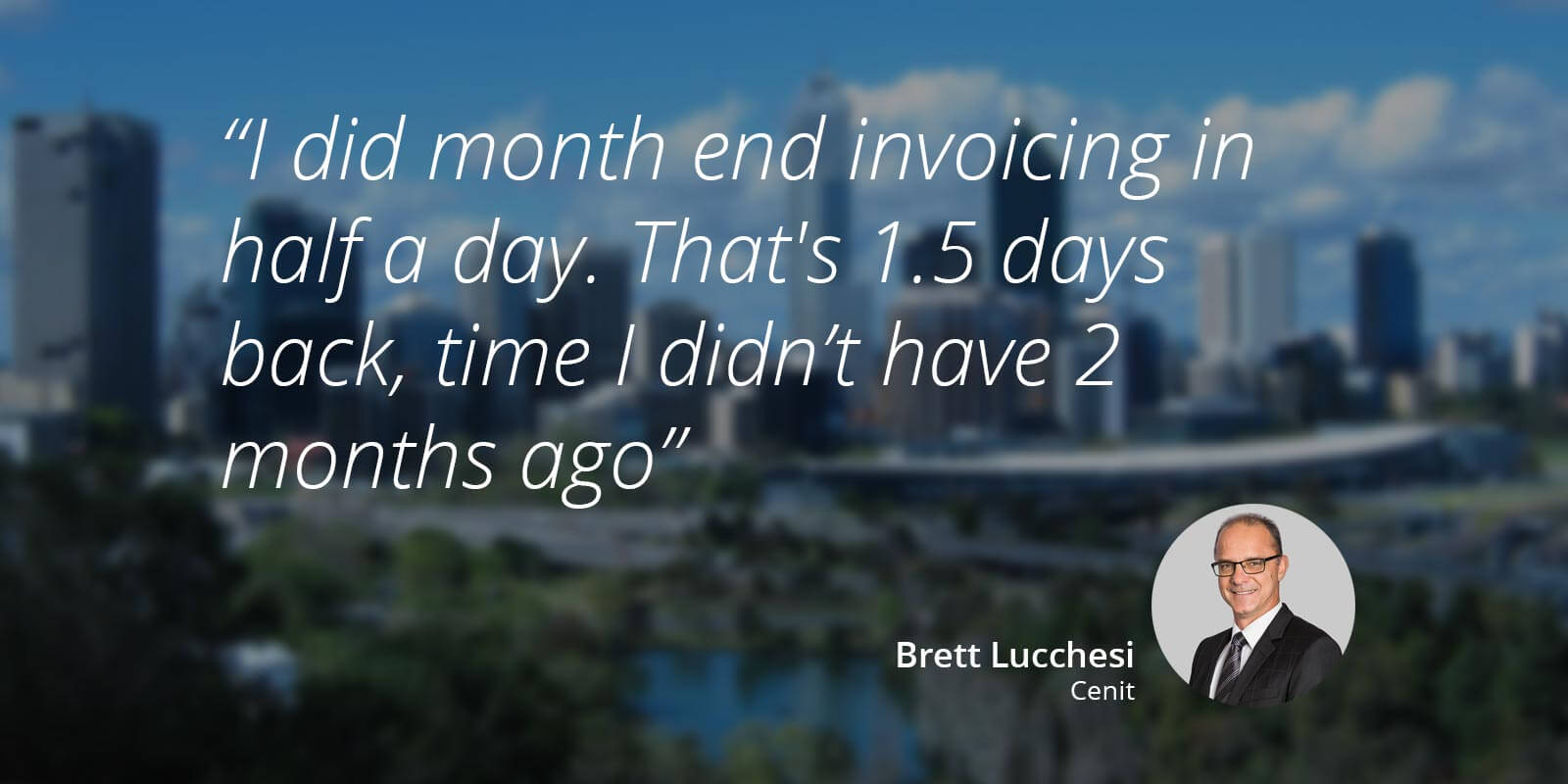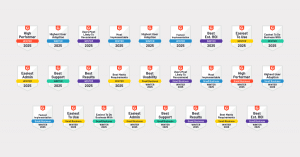Engineers of better business — Brett Lucchesi, Cenit
In a small consulting engineering firm, what’s the principal’s role? Is there just one thing you can point to? (Feel free to comment below.)
Cenit is a consulting structural engineering practice in Perth, Western Australia, founded in July 2016. We asked founder and managing director Brett Lucchesi about his role in the business. “Which one?”, he said.
One thing is clear — time is a premium. The right technology mix used well can help dramatically improve time savings in running a consulting design business. Within two months of using Synergy, Brett reduced his invoicing time by 75 percent.
The small firm juggle
When you’re a team of four, working across residential, commercial and industrial structural engineering, the managing director (owner, director, whatever your title) is the project manager, new business hunter, design engineer, administrator, business manager, consultant, customer relationship manager, dispute resolver, HR manager, chaser-of-timesheets-with-a-big-stick-(including-their-own), payroll person, and any other roles you can think of.
How well this person does at each of those roles determines the reputation of the business — as consultant, designer, employer. To focus on any part of that, you need time. You need to streamline a lot of the everyday business processes so you can find the time to build relationships, establish a reputation, employ the right people, and grow the business.
This is Brett Lucchesi’s point of view of starting up a new consulting firm after successfully running (and selling) his own business for 24 years. It’s a story of how the right technology can help save time.
Cenit
Brett started Cenit in July 2016. It’s currently a team of four (October 2017) and works in residential, commercial and industrial sectors.
“We work on multi-residential apartment-type complexes throughout the metropolitan area and the greater metro area,” Brett says.
“We’re in luxury residential at the higher end residential market.
“Commercial varies from offices to retail to medical, and industrial is more warehouse and manufacturing type facilities.”
In terms of project types, Cenit’s work spans from new builds to complex extensions and renovations.
“In the commercial and industrial space, it’s pretty much always new builds,” he says.
“In the residential space, we do a lot of very high-end extensive renovations and extensions. I’m looking at one at the moment which is a major transformation, probably a two-million-dollar renovation to a house.”
Going it alone (again)
What is it that prompted Lucchesi to start up a new consultancy?
“I’ve been in the industry now for far too long… 30 years,” he says.
“I was three years into my career and started my own business with another guy who was actually my first boss when I came out of university. We started a company called E-Tec Consultants, that was back in 1989.
“I was the young engineer and [my partner] had a bit of experience on me and I ended up sort of running that business and had it for 24 years.
“We were approached in 2012 by a national consulting practice that wanted a presence in Perth. We’d been approached before, but this one seemed to tick all the boxes and we decided to sell after 24 years.”
Long story short, E-Tec was a team of 18-20 people when acquired, now there’s one left. Brett’s role changed, the culture changed, and the autonomy was gone. Brett had planned to retire at this firm, but after facing demands to meet numbers, sit in meetings and, in effect, work in a national business that had become about labour hire, he felt it wasn’t going to work for him.
“Consulting in Perth is not labour hire, it’s relationships… it just didn’t work,” he says.
“That’s what it was and I had to make a decision on what to do with my career. You know, I was getting on a bit. I wasn’t happy. I kept talking to my wife about what I was going to do, and she said, well we need income, we’ve got four kids, and you can’t just put yourself out on the street.
“So I thought, I’ve been around for a while, I’m well enough known to pick up some work, so I resigned and started up this little practice.”
Fresh starts
Brett used Synergy Practice Management as the practice management software at E-Tec (the on-premises product available before Synergy cloud version).
“Originally we had our own project management software that we had written for us. It became clunky and cumbersome, then the IT guy who’ written it left and we had no one at the company that could keep it up-to-date. It still worked but it was struggling as we grew.
“We had heard of Synergy earlier, so we jumped on it, and ended up using it for a number of years. We kept using it after we sold our business, despite it not being the system in the company that acquired us. They eventually changed to something else across their offices around Australia, New Zealand and Asia.
“[The system they chose] was a catastrophic disaster to roll out. I hated it because I was so Synergy trained, and to me, it was inventory software not a system designed for consulting.”
Consulting software
So what is it that a consulting engineer practice needs?
“I’m only one consultant and we might not all see it the same way, but I need the information to be all there,” Brett says.
“I’m the director wanting to see, let’s say, numbers, performance, whatever it might be; or I’m the project manager who wants to track the probability of the project, budgeted hours versus actual hours; or I’m the admin — which I do with my wife — doing invoicing and synching everything to Xero.
“You know, to an assistant project manager, with enough ability to get in and look at stuff but not have the ability to invoice, to a user who can check timesheets and find jobs and find contacts, it’s just easy for everybody. It just makes sense. I’m an engineer, so logic is how we work — we like solving problems. Synergy helps me solve my problems because it’s logical. It makes sense.”
Reduce invoicing time (by 75 percent!) and get paid faster
A new feature for Cenit in Synergy was the Xero accounting software add-on. This connects Synergy to Xero and means there’s no need for double entry of invoices and payments. It also allows for exchange of contact information and a few other things.
In the first two months, using Synergy and Xero in combination has saved Brett approximately a day and a half in time per month. He reduced his invoicing time by 75 percent.
“The connection between Synergy and Xero is perfect,” he says.
“I’m looking at the Synergy screen, my wife’s looking at the Xero screen, and we’re looking at exactly the same information.
“It was probably taking me around two days to do my monthly invoicing, which is not very effective from a time and a cost point of view.
“I did my August invoicing in half a day from Synergy. That gives me a day-and-a-half back, time I didn’t have had two months ago.
“I usually prefer to do invoicing at the end of a month, but now, if a client rings up and asks for an invoice, I can send it almost immediately. Before I had to go and find all the info and build the invoice, now I go click, click, click, done, check and send. And it’s gone. What’s even better is that the clients who ask for that are often the ones who pay quickly.
“If I invoice a client and they’re willing to pay within seven days, why wouldn’t I? It makes no sense not to. It doesn’t make any difference when you do the invoicing, but the ones that are willing to pay within seven days means your cash flow becomes way better.”
Synergy makes it easier to send invoices more often in less time. But when the invoicing is done by one person — often the principal — does it make sense to push the invoicing control down to project managers?
“Yes,” Brett says.
“And they’ll be given the same instructions: invoice when you can. Based on the terms of the client, if it’s the one-off client that pays on seven days, then you send out the job on the fifth of the month, invoice it on the fifth of the month. You might get paid a week later.”
Project information management
We asked Brett to highlight what he likes best about Synergy. He is pretty enthusiastic about the Xero add-on for Synergy, but it came down to centralised project information.
“All my project information is at my fingertips,” he says.
“I need to be able to see what’s active, what’s in proposal status… I can do that on my spreadsheets as well, but everything I need to know about the project is in one place now.
“Before, I had spreadsheets for projects, for proposals, for invoicing, so I had to go through two or three spreadsheets to find everything. Now it’s just on one screen.
“Synergy saves time. It’s easy to use and it saves me time. It saves everybody time. So therefore, everybody can be more productive. We get more utilisation out of everybody.”




